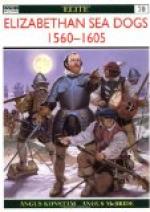In her own day the galleon was the ‘great ship,’ ‘capital ship,’ ‘ship-of-the-line-of-battle,’ or ‘battleship’ on which the main fight turned. But just as our modern fleets require three principal kinds of vessels—battleships, cruisers, and ‘mosquito’ craft—so did the fleets of Henry and Elizabeth. The galleon did the same work as the old three-decker of Nelson’s time or the battleship of to-day. The ‘pinnace’ (quite different from more modern pinnaces) was the frigate or the cruiser. And, in Henry VIII’s fleet of 1545, the ‘row-barge’ was the principal ‘mosquito’ craft, like the modern torpedo-boat, destroyer, or even submarine. Of course the correspondence is far from being complete in any class.
The English galleon gradually developed more sail and gun power as well as handiness in action. Broadside fire began. When used against the Armada, it had grown very powerful indeed. At that time the best guns, some of which are still in existence, were nearly as good as those at Trafalgar or aboard the smart American frigates that did so well in ‘1812.’ When galleon broadsides were fired from more than a single deck, the lower ones took enemy craft between wind and water very nicely. In the English navy the portholes had been cut so as to let the guns be pointed with considerable freedom, up or down, right or left. The huge top-hampering ‘castles’ and other soldier-engineering works on deck were modified or got rid of, while more canvas was used and to much better purpose.
The pinnace showed the same sort of improvement during the same period—from Drake’s birth under Henry VIII in 1545 to the zenith of his career as a sea-dog in 1588. This progenitor of the frigate and the cruiser was itself descended from the long-boat of the Norsemen and still used oars as occasion served. But the sea-dogs made it primarily a sailing vessel of anything up to a hundred tons and generally averaging over fifty. A smart pinnace, with its long, low, clean-run hull, if well handled under its Elizabethan fighting canvas of foresail and main topsail, could play round a Spanish galleasse or absurdly castled galleon like a lancer on a well-trained charger round a musketeer astraddle on a cart horse.[4] Henry’s pinnaces still had lateen sails copied from Italian models. Elizabeth’s had square sails prophetic of the frigate’s. Henry’s had one or a very few small guns. Elizabeth’s had as many as sixteen, some of medium size, in a hundred-tonner.
[4: Fuller in his Worthies (1662) writes: ’Many were the wit-combats betwixt him [Shakespeare] and Ben Jonson, which two I beheld like a Spanish great galleon and an English man-of-war: Master Jonson (like the former) was built far higher in learning, solid but slow in his performances. Shakespeare, like the English man-of-war, lesser in bulk, but lighter in sailing, could turn with all tides, tack about, and take advantage of all winds by the quickness of his wit and invention.’]




